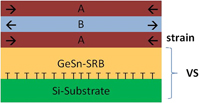Crossref Citations
This article has been cited by the following publications. This list is generated based on data provided by
Crossref.
Perova, T. S.
Kasper, E.
Oehme, M.
Cherevkov, S.
and
Schulze, J.
2017.
Features of polarized Raman spectra for homogeneous and non‐homogeneous compressively strained Ge1−ySny alloys.
Journal of Raman Spectroscopy,
Vol. 48,
Issue. 7,
p.
993.
Yurasov, D.V.
Antonov, A.V.
Drozdov, M.N.
Yunin, P.A.
Andreev, B.A.
Bushuykin, P.A.
Baydakova, N.A.
and
Novikov, A.V.
2018.
Structural and electrical properties of Ge-on-Si(0 0 1) layers with ultra heavy n-type doping grown by MBE.
Journal of Crystal Growth,
Vol. 491,
Issue. ,
p.
26.
Onufrijevs, Pavels
Ščajev, Patrik
Medvids, Arturs
Andrulevicius, Mindaugas
Nargelas, Saulius
Malinauskas, Tadas
Stanionytė, Sandra
Skapas, Martynas
Grase, Liga
Pludons, Arturs
Oehme, Michael
Lyutovich, Klara
Kasper, Erich
Schulze, Joerg
and
Cheng, Hung Hsiang
2020.
Direct-indirect GeSn band structure formation by laser Radiation: The enhancement of Sn solubility in Ge.
Optics & Laser Technology,
Vol. 128,
Issue. ,
p.
106200.
Ščajev, Patrik
Soriūtė, Vaiva
Kreiza, Gediminas
Malinauskas, Tadas
Stanionytė, Sandra
Onufrijevs, Pavels
Medvids, Arturs
and
Cheng, Hung-Hsiang
2020.
Temperature dependent carrier lifetime, diffusion coefficient, and diffusion length in Ge0.95Sn0.05 epilayer.
Journal of Applied Physics,
Vol. 128,
Issue. 11,
Ščajev, Patrik
Soriūtė, Vaiva
Kreiza, Gediminas
Nargelas, Saulius
Dobrovolskas, Darius
Malinauskas, Tadas
Subačius, Liudvikas
Onufrijevs, Pavels
Varnagiris, Sarunas
and
Cheng, Hung-Hsiang
2021.
Temperature and spatial dependence of carrier lifetime and luminescence intensity in Ge0.95Sn0.05 layer.
Materials Science and Engineering: B,
Vol. 270,
Issue. ,
p.
115204.
Ščajev, Patrik
Onufrijevs, Pavels
Mekys, Algirdas
Malinauskas, Tadas
Augulis, Dominykas
Subačius, Liudvikas
Lee, Kuo-Chih
Kaupuzs, Jevgenijs
Varnagiris, Sarunas
Medvids, Arturs
and
Hsiang Cheng, Hung
2021.
Extension of spectral sensitivity of GeSn IR photodiode after laser annealing.
Applied Surface Science,
Vol. 555,
Issue. ,
p.
149711.
Novikov, Alexey V.
Smagina, Zhanna V.
Stepikhova, Margarita V.
Zinovyev, Vladimir A.
Rudin, Sergey A.
Dyakov, Sergey A.
Rodyakina, Ekaterina E.
Nenashev, Alexey V.
Sergeev, Sergey M.
Peretokin, Artem V.
and
Dvurechenskii, Anatoly V.
2021.
One-Stage Formation of Two-Dimensional Photonic Crystal and Spatially Ordered Arrays of Self-Assembled Ge(Si) Nanoislandson Pit-Patterned Silicon-On-Insulator Substrate.
Nanomaterials,
Vol. 11,
Issue. 4,
p.
909.
